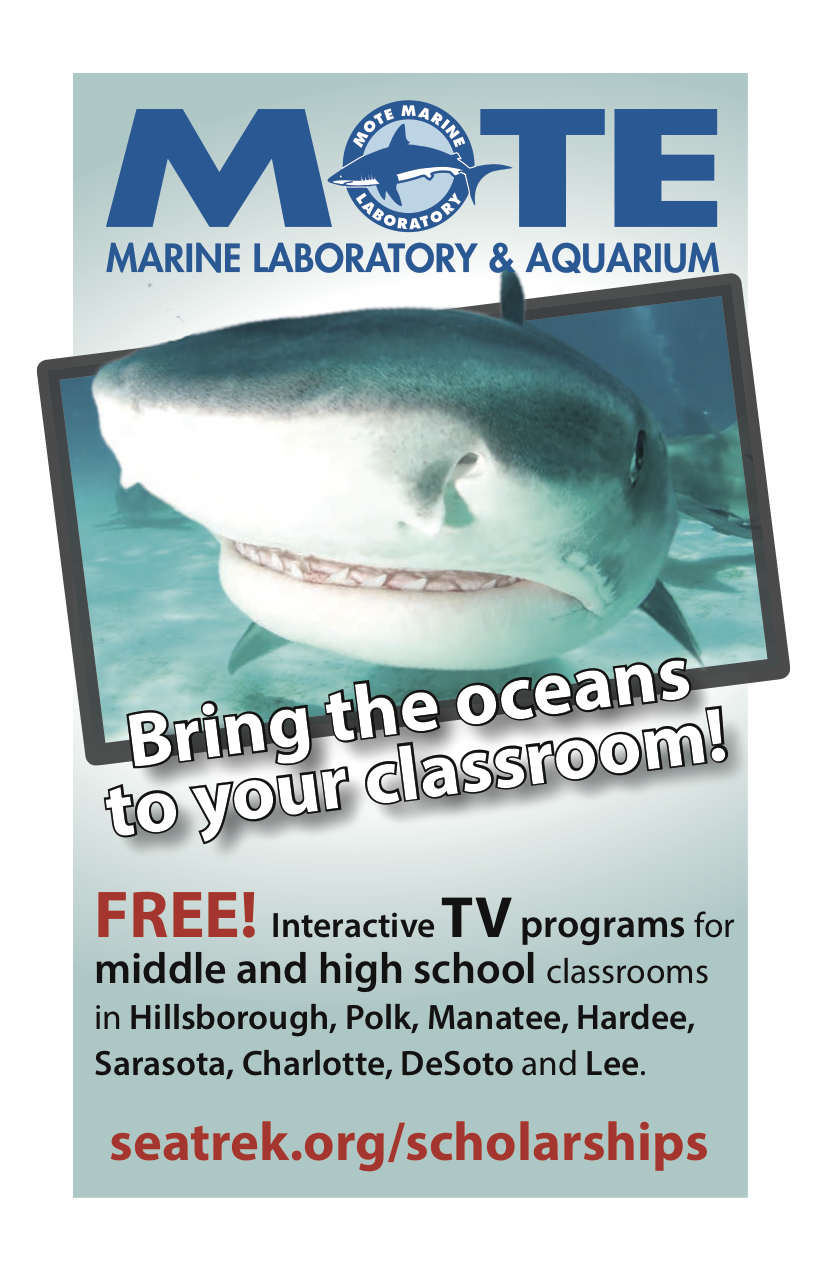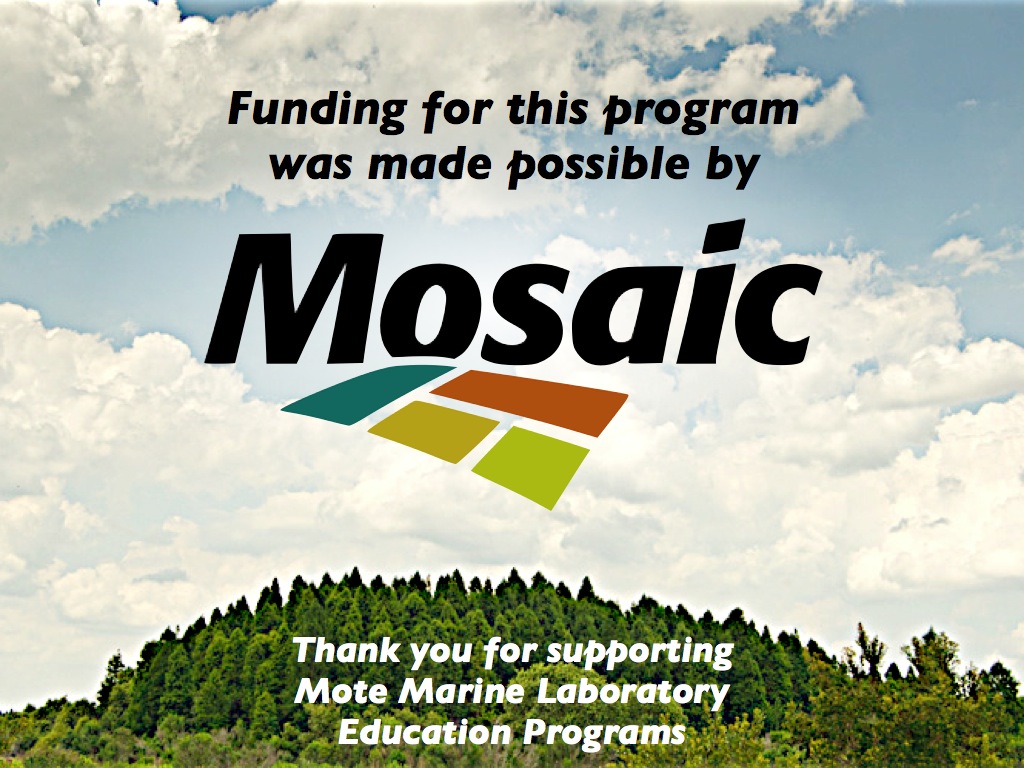SeaTrek Scholarships

Mote Marine Laboratory received funding from the Mosaic Company Foundation for the enhancement and delivery of SeaTrek Interactive Programs to regional classrooms. Mote Marine Laboratory is an award-winning Interactive Videoconference (IVC) provider of live programming for K-12 students and has had great success in reaching school audiences through our SeaTrek distance learning programs.
What does a SeaTrek program look like?
The program is a live, two-way interactive program focused on shark research at Mote Marine Laboratory. The first 15 minutes covers the shark husbandry and training we perform at our aquarium as well as the ground-breaking research technology that we use in the field. This is followed by a general Question and Answer session with our Ocean Experts.
Who can particiapte?
The Mosaic funds will allow Mote Marine to assist regional Florida schools in purchasing SeaTrek programs to compliment and enhance their existing STEM curriculum. The funds will provide 100 SeaTrek program scholarships to schools in Manatee, Sarasota, Hardee, DeSoto, Charlotte, Lee, Polk and Hillsborough counties. These scholarships have a value of $125 each. Scholarships are offered on a first come, first serve basis. We will begin scheduling SeaTrek scholarship programs starting in late January, 2013 and running through May, 2013. Limit of up to five scholarships per site.
Program Title: Sharks Express
Overview: In this videoconference, Mote Marine Laboratory will present a media-rich videoconference featuring a narrated feeding from our shark habitat.
- Countdown (7 min.)
- Narrated feeding (8 min.)
- Question and Answer (10 min.)
Links:
Applicable Sunshine State Standards:
3rd Grade
- SC.3.N.1 The Practice of Science
- Benchmarks SC.3.N.1.1, SC.3.N.1.4, SC.3.N.1.7
- SC.3.L.15 Diversity and Evolution of Living Organisms
- Benchmark SC.3.L.15.1
4th Grade
- SC.4.N.1 The Practice of Science
- Benchmarks SC.4.N.1.1, SC.4.N.1.8
- SC.4.N.2 The Characteristics of Scientific Knowledge
- Benchmark SC.4.N.2.1
- SC.4.L.16 Heredity and Reproduction
- Benchmark SC.4.L.16.3
- SC.4.L.17 Interdependence
- Benchmarks SC.4.L.17.2, SC.4.L.17.4
5th Grade
- SC.5.E.7 Earth Systems and Patterns
- Benchmark S.5.E.7.2
- SC.5.L.14 Organization and Development of Living Organisms
- SC.5.L.15 Diversity and Evolution of Living Organisms
- Benchmark SC.5.L.15.1
- SC.5.L.17 Interdependence
- Benchmark SC.5.L.17.1
6th Grade
- SC.6.N.2 The Characteristics of Scientific Knowledge
- Benchmarks SC.6.N.2.2, SC.6.N.2.3
- SC.6.L.14 Organization and Development of Living Organisms
- SC.6.L.15 Diversity and Evolution of Living Organisms
- Benchmark SC.6.L.15.1
7th Grade
- SC.7.L.15 Diversity and Evolution of Living Organisms
- Benchmark SC.7.L.15.2
- SC.7.L.16 Heredity and Reproduction
- SC.7.L.17 Interdependence
- Benchmark SC.7.L.17.1
8th Grade
- SC.8.N.4 Science and Society
- Benchmarks SC.8.N.4.1, SC.8.N.4.2
Grades 9 -12
- SC.912.N.1 The Practice of Science
- Benchmarks SC.912.N.1.4, SC.912.N.1.7
- SC.912.N.2 The Characteristics of Scientific Knowledge
- Benchmark SC.912.N.2.4
- SC.912.N.4 Science and Society
- Benchmark SC.912.N.4.1
- SC.912.L.15 Diversity and Evolution of Living Organisms
- Benchmark SC.912.L.15.3
- SC.912.L.17 Interdependence
- Benchmarks SC.912.L.17.1, SC.912.L.17.6, SC.912.L.17.8, SC.912.L.17.13, SC.912.L.17.15, SC.912.L.17.17, SC.912.L.17.18, SC.912.L.17.20
Ocean Literacy Principles
Principle #1: The Earth has one big ocean with many features
a. The ocean is the dominant physical feature on our planet Earth—covering
approximately 70% of the planet’s surface. There is one ocean with many ocean basins,
such as the North Pacific, South Pacific, North Atlantic, South Atlantic, Indian and Arctic.
g. The ocean is connected to major lakes, watersheds and waterways because all major
watersheds on Earth drain to the ocean. Rivers and streams transport nutrients, salts,
sediments and pollutants from watersheds to estuaries and to the ocean.
h. Although the ocean is large, it is finite and resources are limited.
Principle #5: The ocean supports a great diversity of life and ecosystems
d. Ocean biology provides many unique examples of life cycles, adaptations and
important relationships among organisms (such as symbiosis, predator-prey dynamics
and energy transfer) that do not occur on land.
Principle #6: The ocean and humans are inextricably interconnected.
e. Humans affect the ocean in a variety of ways. Laws, regulations and resource
management affect what is taken out and put into the ocean. Human development and
activity leads to pollution (such as point source, non-point source, and noise pollution)
and physical modifications (such as changes to beaches, shores and rivers). In addition,
humans have removed most of the large vertebrates from the ocean.
g. Everyone is responsible for caring for the ocean. The ocean sustains life on Earth and
humans must live in ways that sustain the ocean. Individual and collective actions are
needed to effectively manage ocean resources for all.
Principle #7: The ocean is largely unexplored.
a. The ocean is the last and largest unexplored place on Earth—less than 5% of it has
been explored. This is the great frontier for the next generation’s explorers and
researchers, where they will find great opportunities for inquiry and investigation.
b. Understanding the ocean is more than a matter of curiosity. Exploration, inquiry and
study are required to better understand ocean systems and processes.
c. Over the last 40 years, use of ocean resources has increased significantly, therefore
the future sustainability of ocean resources depends on our understanding of those
resources and their potential and limitations.
d. New technologies, sensors and tools are expanding our ability to explore the ocean.
Ocean scientists are relying more and more on satellites, drifters, buoys, subsea
observatories and unmanned submersibles. Project Technology
Project Technology
SeaTrek programs are all live and delivered to small audiences, usually one classroom at a time, via H.323 videoconferencing (Cisco, Polycom, LifeSize, etc.). This format gives participating students an opportunity to interact with the Mote educators, ask questions and fully engage in the experience. However with evolving technology, the ability to connect virtually has become increasingly less costly and equipment dependent through webconferencing platforms like Skype, Blackboard Collaborate and Safari Montage Live, allowing access to many that previously couldn’t utilize SeaTrek programming.
Sites must make a successful test connection before scheduling programs. Testing information will be sent after successfully completing a scholarship application (below).
 Application Signup
Application Signup
Click here to open this form in a new window

